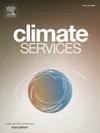Observed climate trends and farmers’ adaptation strategies in Dendi District, West Shewa Zone, Ethiopia
IF 4
3区 环境科学与生态学
Q2 ENVIRONMENTAL SCIENCES
引用次数: 0
Abstract
Climate change has adversely affected the livelihoods of people in developing countries where a large proportion of the population is heavily dependent on agriculture. Indigenous people need to perceive that the climate is changing or likely could change, and they need to pay sufficient attention to this perception to take action. Understanding farmers’ perceptions about climate change and adaptation strategies can help support their efforts and develop interventions more suited to the local context. Hence, this study aimed to elucidate how farmers perceive climate change in their locality and how they adapt to observed changes in the Dendi district, West Shewa Zone, Oromia Regional State, Ethiopia. Semi-structured interviews were conducted to gather information on farmers’ perceptions of climate change, observed threats, and adaptation practices to observed changes from 144 sample farmers. Key informant interviews and focus group discussions were also conducted to gather more insights into trends in climate change, threats, and adaptation practices in the area. Additionally, climate data of the district from 1990 to 2021 were analyzed to assess trends in temperature and rainfall in the study area. The findings of the study revealed an increasing trend in maximum temperatures in the study area, while the mean minimum temperatures slightly decreased. Rainfall trends have significantly decreased over the past three decades, with seasonal rainfall also declining. The majority of the respondents replied that they perceived an increase in temperature and a decrease in rainfall. Specifically, 79.2% of the respondents perceived rising temperatures, while 16.7% perceived a decrease in temperature. Additionally, 77.1% of respondents replied that there was a decrease in both the amount and distribution of rainfall. The socio-economic analysis reveals that weather events in the study area vary in frequency across agroecologies. The major events identified include prolonged droughts with late-onset or early offset of rains (84.5%), floods/excessive moisture (71.6%), crop disease (70.8%), and erosion (56.9%). As rain-fed crop production relies on the timely and normal distribution of rainfall, these events significantly disrupt agricultural operations, particularly in mid-altitude and lowland areas. The impacts, sometimes, include total crop loss, reduced yields, smaller seeding areas, delayed planting and maturity, and increased crop pests. Respondents reported various climate change adaptation practices, including adjusting cropping calendars, changing crop types, diversifying livelihoods, and adopting improved crop varieties and irrigation. However, the effectiveness of these practices was limited by resource and skill constraints. To enhance resilience, it is crucial to provide reliable climate information, offer training on climate-smart agriculture, ensure access to updated climate data, and promote improved irrigation methods.
在埃塞俄比亚西谢瓦区Dendi区观测到的气候趋势和农民适应策略
气候变化对发展中国家人民的生计产生了不利影响,因为发展中国家很大一部分人口严重依赖农业。土著人民需要认识到气候正在发生变化或可能发生变化,他们需要对这种认识给予足够的重视,以便采取行动。了解农民对气候变化和适应战略的看法有助于支持他们的努力,并制定更适合当地情况的干预措施。因此,本研究旨在阐明农民如何感知其所在地区的气候变化,以及他们如何适应在埃塞俄比亚奥罗米亚州西谢瓦区Dendi区观察到的变化。进行了半结构化访谈,以收集来自144个样本农民的关于农民对气候变化的看法、观察到的威胁以及对观察到的变化的适应做法的信息。还进行了主要信息提供者访谈和焦点小组讨论,以收集有关该地区气候变化趋势、威胁和适应实践的更多见解。此外,分析了1990 - 2021年的气候数据,以评估研究区温度和降雨的趋势。研究结果表明,研究区最高气温呈上升趋势,而平均最低气温略有下降。在过去的30年里,降雨趋势显著减少,季节性降雨也在减少。大多数受访者回答说,他们感觉到气温上升,降雨量减少。具体来说,79.2%的受访者认为气温会上升,16.7%的受访者认为气温会下降。此外,77.1%的回答者认为雨量和分布均有所减少。社会经济分析表明,研究区域的天气事件在不同的农业生态系统中频率不同。确定的主要事件包括降雨迟发或提前抵消的长期干旱(84.5%)、洪水/过度潮湿(71.6%)、作物病害(70.8%)和侵蚀(56.9%)。由于雨养作物的生产依赖于降雨的及时和正常分布,这些事件严重扰乱了农业生产,特别是在中海拔和低地地区。其影响有时包括作物全部损失、产量下降、播种面积缩小、播种和成熟延迟以及作物害虫增加。受访者报告了各种适应气候变化的做法,包括调整种植日历、改变作物类型、使生计多样化以及采用改良作物品种和灌溉。然而,这些实践的有效性受到资源和技能限制的限制。为增强抵御能力,提供可靠的气候信息、提供气候智慧型农业培训、确保获得最新气候数据以及推广改进的灌溉方法至关重要。
本文章由计算机程序翻译,如有差异,请以英文原文为准。
求助全文
约1分钟内获得全文
求助全文
来源期刊

Climate Services
Multiple-
CiteScore
5.30
自引率
15.60%
发文量
62
期刊介绍:
The journal Climate Services publishes research with a focus on science-based and user-specific climate information underpinning climate services, ultimately to assist society to adapt to climate change. Climate Services brings science and practice closer together. The journal addresses both researchers in the field of climate service research, and stakeholders and practitioners interested in or already applying climate services. It serves as a means of communication, dialogue and exchange between researchers and stakeholders. Climate services pioneers novel research areas that directly refer to how climate information can be applied in methodologies and tools for adaptation to climate change. It publishes best practice examples, case studies as well as theories, methods and data analysis with a clear connection to climate services. The focus of the published work is often multi-disciplinary, case-specific, tailored to specific sectors and strongly application-oriented. To offer a suitable outlet for such studies, Climate Services journal introduced a new section in the research article type. The research article contains a classical scientific part as well as a section with easily understandable practical implications for policy makers and practitioners. The journal''s focus is on the use and usability of climate information for adaptation purposes underpinning climate services.
 求助内容:
求助内容: 应助结果提醒方式:
应助结果提醒方式:


